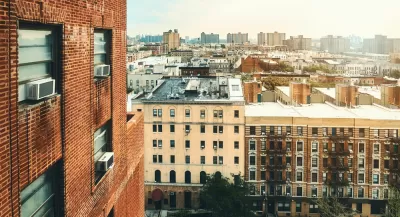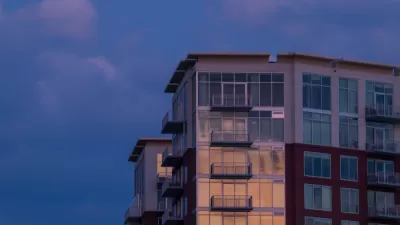Rents have been declining more slowly in the outer boroughs than in Manhattan. Does this mean that what happens in Manhattan has no effect on the rest of the city?

One common argument against new housing is that housing markets are "segmented": that is, if new housing is built in a city's richest neighborhoods, it might benefit residents of those neighborhoods, but it will not benefit residents of faraway parts of the city, or of lower-income areas.
The events of the last year have shown that there is a grain of truth to this claim. Since the dawn of COVID-19, rents have plunged in Manhattan neighborhoods near major business districts. For example, I live in midtown Manhattan, not far from large office buildings. In 2019, I signed a lease requiring me to pay $3,550 for a one-bedroom apartment in a condo. In recent months, similar units in my building have rented for as little as $2,800.
My apartment is not unusual; according to streeteasy.com, the median asking rent for one-bedroom Manhattan apartments decreased from $3,483 in February 2020 to $2,725 in February 2021. By contrast, rents in other parts of the city have declined more slowly. Two years ago, I looked for apartments not only in Manhattan, but also in middle-class parts of Central Queens (Forest Hills, Kew Gardens, and Briarwood): there, rents have declined, but more modestly. The reason for this is, I suspect, that demand has decreased far more in Manhattan than in Queens. Midtown was a desirable neighborhood because of its proximity to office jobs, and when the holders of those jobs began to work remotely, many of them saw no reason to stay in Manhattan. By contrast, central Queens is less connected to Manhattan office jobs. So does this mean that what happens in Midtown never affects Queens?
Not quite. If declining central Manhattan rents had zero effect on other neighborhoods, rents would not have declined at all outside Manhattan. In fact, between February 2020 and February 2021, median one-bedroom rents in Queens decreased from $2,000 to $1,800. In the central Queens neighborhoods I was most interested in, rents fell by slightly less (about 3 to 6 percent).
But what about the least desirable areas? In the Bronx (the poorest borough), rents barely budged: between February 2020 and February 2021, median rents for one-bedroom apartments decreased by only $25. So it might be argued that Bronx rents support an extreme version of the segmentation theory—that is, that reducing rents in Manhattan has no positive effect on Bronx renters.
But this would only be true if, in the absence of COVID-19, rents in the Bronx would have remained unchanged. But in recent years, rents in the Bronx had actually been increasing: between Feb. 2016 and Feb. 2020 rents increased from $1,450 to $1,700 (or by a little over 4 percent a year). Similarly, in the city's second least-expensive borough, Staten Island, rents have been stable over the past year—but between February 2016 and February 2020, median one-bedroom rents increased from $1,500 to $1,795. Thus, it seems to me likely that the same supply-and-demand trends that caused rents to fall in Manhattan prevented rents from rising at the outer edges of the city.
Furthermore, rents would have fallen even more in poor areas were it not for nationwide eviction moratoria. By restricting evictions, government limited the supply of housing available to people looking for apartments, which in turn may have prevented rents from falling. Had government allowed mass evictions, there would have been more vacant apartments, possibly causing rents to decline as rapidly as in Manhattan.
More broadly, if the most extreme version of the segmentation theory was true, rents in affluent areas would have no effect on rents in poor areas. But if this was the case, there would be no correlation between high rents in a city’s affluent districts and high rents in the city’s poorer districts: cities which (like New York or San Francisco) had sky-high rents in rich areas might have ordinary rents in poor areas, and cities with more modest rents in rich areas might have high rents in poor areas.
Even a casual look at Zillow proves that this is not the case: cities where high-end rents are lower than Manhattan also have poor neighborhoods where rents are lower than in the South Bronx. For example, the cheapest one-bedroom listing in the South Bronx costs $1,100 per month, while the cheapest one-bedroom listed in Atlanta rents for $647 and the cheapest one-bedroom in Houston rents for $550.
Does this have any policy implications? It seems to me that it supports my view that in the long run, an adequate supply of new housing reduces rents for everyone. If a wave of new housing caused high-end New York rents to get down to Atlanta levels, low-end New York rents would go down as well. How to achieve that goal is, of course, a subject best left for another essay.
P.S. Because market rents dropped most rapidly in affluent areas, one might think that rent decreases were not useful for lower-income renters. However, a recent study published at streeteasy.com shows that while only 22 percent of relevant units were affordable (by federal standards) to holders of federal housing vouchers in 2019, that percentage increased to 31 percent last year.

Alabama: Trump Terminates Settlements for Black Communities Harmed By Raw Sewage
Trump deemed the landmark civil rights agreement “illegal DEI and environmental justice policy.”

Planetizen Federal Action Tracker
A weekly monitor of how Trump’s orders and actions are impacting planners and planning in America.

Why Should We Subsidize Public Transportation?
Many public transit agencies face financial stress due to rising costs, declining fare revenue, and declining subsidies. Transit advocates must provide a strong business case for increasing public transit funding.

Understanding Road Diets
An explainer from Momentum highlights the advantages of reducing vehicle lanes in favor of more bike, transit, and pedestrian infrastructure.

New California Law Regulates Warehouse Pollution
A new law tightens building and emissions regulations for large distribution warehouses to mitigate air pollution and traffic in surrounding communities.

Phoenix Announces Opening Date for Light Rail Extension
The South Central extension will connect South Phoenix to downtown and other major hubs starting on June 7.
Urban Design for Planners 1: Software Tools
This six-course series explores essential urban design concepts using open source software and equips planners with the tools they need to participate fully in the urban design process.
Planning for Universal Design
Learn the tools for implementing Universal Design in planning regulations.
Caltrans
Smith Gee Studio
Institute for Housing and Urban Development Studies (IHS)
City of Grandview
Harvard GSD Executive Education
Toledo-Lucas County Plan Commissions
Salt Lake City
NYU Wagner Graduate School of Public Service






























